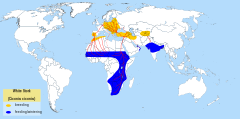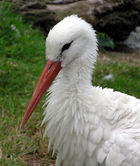White Stork
| White Stork | |
|---|---|
.jpg) |
|
| Conservation status | |
| Scientific classification | |
| Kingdom: | Animalia |
| Phylum: | Chordata |
| Class: | Aves |
| Order: | Ciconiiformes |
| Family: | Ciconiidae |
| Genus: | Ciconia |
| Species: | C. ciconia |
| Binomial name | |
| Ciconia ciconia (Linnaeus, 1758) |
|
 |
|
| Distribution and migration of the White Stork | |
The White Stork (Ciconia ciconia) is a large wading bird in the stork family Ciconiidae, breeding in the warmer parts of Europe (south to Estonia), northwest Africa, and southwest Asia (east to southern Kazakhstan). It is a strong migrant, wintering mainly in tropical Africa, down to the south of South Africa, and also in the Indian subcontinent.
It is a huge bird, 100–125 cm (40–50 inches) tall, with a 155–200 cm (61–79 in) wingspan and a weight of 2.3–4.5 kg (5–10 lbs). It is completely white except for the black wing flight feathers, and its red bill and legs, which are black on juveniles. It walks slowly and steadily on the ground. Like all storks with the exception of the Leptoptilos genus, it flies with its neck outstretched.
There are two subspecies (HBW):
- Ciconia ciconia ciconia Linnaeus, 1758. Europe, northwest Africa, westernmost Asia; wintering in Africa.
- Ciconia ciconia asiatica Severtsov, 1873. West-central Asia; wintering in India.
The Oriental White Stork (Ciconia boyciana), now regarded as a distinct species, was formerly treated as a subspecies of the White Stork.
Contents |
Conservation and population
Notable breeding totals occur mainly in central and eastern Europe, with 52,500 pairs in Poland (6th International Census of White Stork, 2004),[2] 12,000-18,000 pairs in Ukraine, 10,500-13,000 pairs in Belarus, 10,000 pairs in Lithuania, the highest known density of this species in the world, and 8,500 pairs in Latvia. In Estonia the population has also been increasing, numbering about 4000 pairs in 2004. There also exist around 5,000 of pairs in Romania. In Germany, 3,000 of the total 3,400 pairs are in the former East Germany. In southwestern Asia, Turkey has the highest population, with 15,000-35,000 pairs. Apart from Spain (14,000 pairs) and Portugal (ca. 10,000 pairs in 2008), numbers in western Europe are much less healthy, with the once sizable Danish population declining to just five pairs in 1995, while re-introductions of zoo-reared birds have halted declines in Italy (30 pairs), the Netherlands (9-12 pairs), and Switzerland (120-160 pairs). A few pairs also breed in South Africa, recent colonists from within the normal wintering population (HBW). Bulgaria also plays host to thousands of breeding pairs every year, The last count of white storks in Bulgaria has been conducted in 2004/ 2005 and the Bulgarian Bird Protection Society found 4,818 breeding pairs (Novinte.com March 7, 2009, Saturday). North of the breeding range, it is a passage migrant or vagrant in Finland, Great Britain, Iceland, Ireland, Norway, and Sweden, and also west to the Azores and Madeira. In the last years range is expansed into Western Russia areas. Data (except Poland and South Africa): Snow & Perrins 1998.
Threats to the species include the drainage of wetlands and other agricultural intensification, collisions with overhead power lines, use of persistent pesticides (such as DDT) to combat locusts in Africa, and (largely illegal) hunting on passage and the wintering grounds (HBW). Some birds, known in German as Pfeilstorch ("arrow storks"), have been found in Europe with African arrows embedded in their bodies.
The White Stork is one of the species to which the Agreement on the Conservation of African-Eurasian Migratory Waterbirds (AEWA) applies.
France
Twenty five years ago the population of this "iconic emblem of Alsace", the bird revered for bringing fertility and luck to any home upon which it nested, had fallen to fewer than nine pairs in the entire upper Rhine River Valley, an area closely identified with the White Stork for centuries. Conservation efforts there, particularly by the Association for the Protection and Reintroduction of Storks in Alsace and Lorraine, have successfully increased the population of birds to 270 pairs.[3]
Behaviour
White Storks rely on movement between thermals of hot air for long distance flight, taking great advantage of them during annual migrations between Europe and Sub-Saharan Africa. The shortest route south would take them over the Mediterranean, but since thermals only form over land, storks take a detour. The options are limited, because to the east lies the Arabian Desert, where it is difficult to find food and water - and to the west lies the Atlantic Ocean. This leaves two narrow migration corridors: eastern storks cross the straits of Bosporus to Turkey, traverse the Levant (Syria-Lebanon-Israel-Palestine), and then bypass the Sahara Desert by following the Nile, while western ones fly through the straits of Gibraltar. Either way, the storks can get help from the thermals for almost the entire trip and thus save energy.[4]
White storks breed in open farmland areas with access to marshy wetlands, building a stick nest in trees, on buildings, or special platforms[5]. Because it is viewed as bird of good luck, it is not persecuted, and often nests close to human habitation. In southern Europe, storks' nests can be seen on churches and other buildings. It often forms small colonies. Like most of its relatives, it feeds on fish, frogs and insects but also eats small reptiles, rodents and smaller birds.
The white stork is almost silent except for the noisy mutual bill-clattering when adults meet at the nest.
Cultural associations

According to mythology, the 'stork' is responsible for bringing babies to new parents. This story probably came about because White Storks have a habit of nesting on buildings in urban areas, so they are often seen around human habitation.
Poles, Lithuanians and Ukrainians believe that storks bring harmony to a family on whose property they nest. The White Stork is the national bird of Lithuania. Also widespread in Poland, it was a Polish mascot at the Expo 2000 Fair in Hanover.[6] Polish poet Cyprian Kamil Norwid mentioned Polish storks in his poem Moja piosenka (II) ("My Song (II)"):
| “ | For the land where it's a great travesty To harm a stork's nest in a pear tree, For storks serve us all... I am homesick, Lord!... |
” |
|
—Cyprian Kamil Norwid, Moja piosnka (II), |
||
In western part of Ukraine it's called buziok. There it is associated with the start of a new family in a new home. In Ukraine the bird is considered as the Messenger of Spring, because it is one of the first birds to return to Ukraine after wintering. It is also - set against a yellow and green background - the symbol of the city of The Hague, Netherlands.
Gallery
 Family, Lithuania |
 Juveniles |
White Stork |
White Stork |
|
White Stork |
 White Stork |
 Flying |
 Feeding the young |
 Two young storks a few days before leaving the nest for the first time |
 Family shortly after one of the adults arrives |
 Juveniles |
 Welcoming the newly arrived |
 Gliding |
 First flight, first landing, third attempt |
 The young left the nest three weeks ago |
 Tree |
 Drawing of white stork |
 A flock of white storks during autumn migration above Israel |
Nesting in early Spring, Aabach (Greifensee) in Wetzikon, Switzerland |
 A stork couple in a nest on a chimney |
Notes and references
- Handbook of the Birds of the World (HBW) 1: 460-461. Lynx Edicions.
- Snow, D. W. & Perrins, C. M. (1998). The Birds of the Western Palearctic, Concise Edition. Oxford.
- ↑ BirdLife International (2008). Ciconia ciconia. In: IUCN 2008. IUCN Red List of Threatened Species. Downloaded on 3 February 2009. Database entry includes justification for why this species is of least concern
- ↑ Nabu.de
- ↑ "French Region Saves Iconic White Storks From Brink: Population Hits 270 Pairs After Dwindling to Nine" by Molly Moore, A10, June 22, 2008 in The Washington Post.
- ↑ Alexander, R. Mcneill (1992). Exploring Biomechanics, Animals in Motion. New York: Scientific American Library. ISBN 0-7167-5035-X
- ↑ “The White Stork in Poland”. (Eds.) Piotr Tryjanowski, Tim H. Sparks, Leszek Jerzak .- Poznań : Bogucki Wydaw. Naukowe, 2006, 500 s. .- ISBN 83-60247-35-8
- ↑ Did you know, that..., from Poland.pl, http://storks.poland.pl/didyou/index.htm, retrieved 7 February 2009